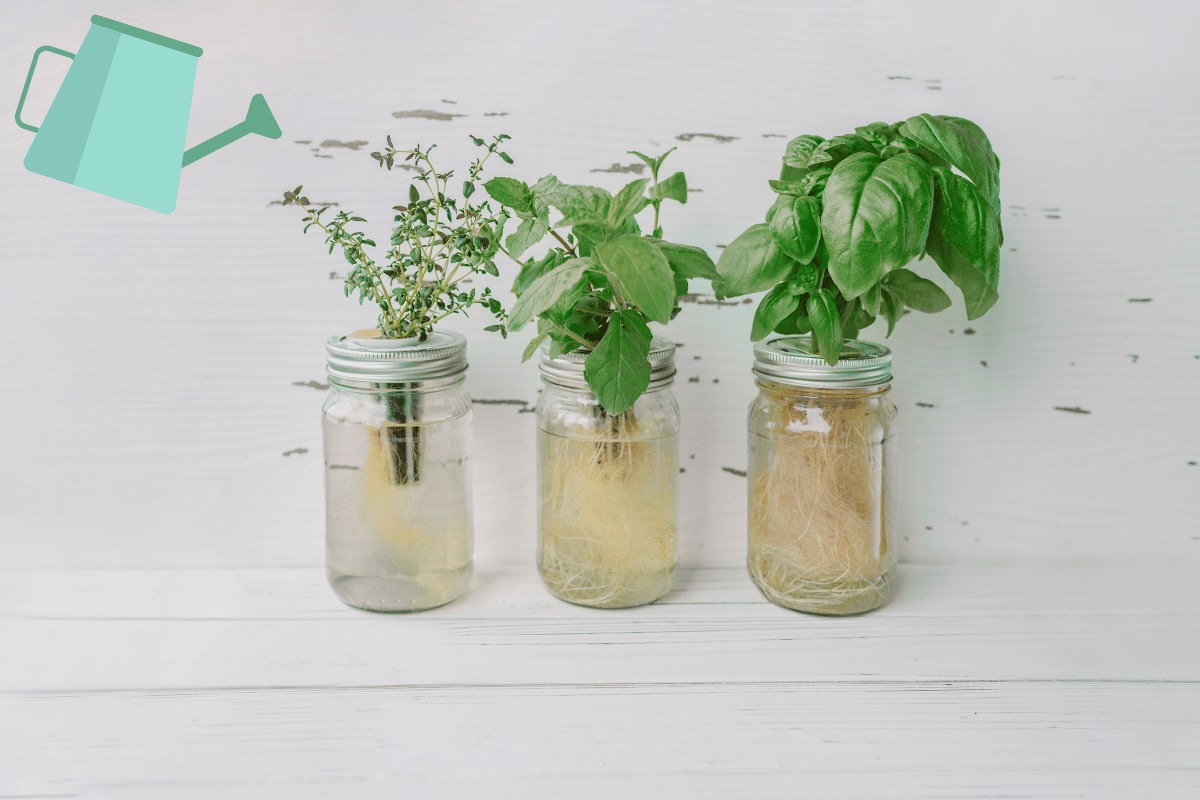When I started to use my homemade mason jar hydroponics, also called the Kratky method, I was pretty confused about how much water I was supposed to use for the method.
In traditional hydroponics, you basically provide as much water as possible, but the Kratky method has a set container and amount of water.
So how much do we need to use?
When using the Kratky method, you fill your container full of a hydroponic solution while leaving a 1/4-1/2″ air gap beneath the root crown for oxygenation. In the life of a small plant, one gallon of the solution is enough, though you may need to refill depending on the size of the jar or container.

Table of Contents
How Much Water Do You Need For Hydroponics?
The short answer: Use as much water as the plants need to grow fully.
The long answer: It depends on the size of the plant and the system you use.
The Kratky method is more efficient on the water as the roots soak in the water the entire time, so you’ll use less than if you were to use an Ebb and Flow or Nutrient Film Technique method.
You always want to make sure there’s enough to keep the plant hydrated between refills.
Most plants can come back from dryness, but it’s better not to risk it if possible.
In general, here’s the rule for how much water each size plant needs:
| Size Plant | Amount of Water |
| Small plant | 1/2 gallon |
| Medium plant | 1 gallon |
| Large plant | 2 1/2 gallons |
If you have multiple plants drawing from one hydroponic reservoir or jar, you’ll need to add this amount together.
For example, if you keep 1 large plant, 2 medium, and 4 small plants, you’ll need 6 1/2 gallons.
In the Kratky method, you’ll be stuck to whatever your jar or other containers can hold.
This means you’ll have to check the water levels more and make sure your container is large enough to hold enough water to reach the roots.
Can I Use Tap Water With The Kratky Method?
Tap water is a tricky topic with hydroponic systems.
If you live in an area with treated water, city water as we call it where I’m from in Michigan, there’s a chance you’ll have high levels of chlorine or chloramine.
This will throw off your hydroponic solution and kill your plants pretty quickly.
Fortunately, there are a few ways to remove the chlorine and chloramine quickly.
Fill a container with water and leave it out in the sun for 24 hours.
This will remove any low levels of chlorine left in the water.
Chloramine is a bit trickier to get rid of.
Cut one lemon in half for every gallon of water you have and let the lemons sit.
The lemon juice will negate a lot of the effects.
Don’t worry if you didn’t realize there are low chlorine or chloramine levels in your city water.
This is a normal disinfectant and perfectly safe for drinking.
It simply causes problems with the Kratky method and hydroponics.
How Often Do You Change Water In Hydroponics?
Hydroponic water needs to be changed every 2-3 weeks in a traditional system.
When the container is half empty of water, refill with some regular water, no nutrients. This will prevent pockets of hypernutrition.
Continue to add regular water until 2 or 3 weeks have passed, remove all the old water, and put in a new, fresh hydroponic solution.
If you’re going through a lot of water and needing to refill multiple times within a 2 week period, consider a larger hydroponic reservoir.
Check out these DIY hydroponic reservoir ideas to check out.
Kratky systems often don’t have the luxury of keeping a lot of water in one container, so you’ll need to be prepared to refill and change the water more often.
Most of the time, Kratky users opt for jars, called mason jar hydroponics (click the link to visit our complete guide).
With this system, I’ve found success with a once-fill, once-replace schedule.
I check on the water daily, and when the water gets close to the bottom of the roots OR the water is halfway down the jar, I fill it back up to a 1/2″ inch gap between the root crown and the water.
When this happens a second time, I replace all the water with a fresh hydroponic solution.
This method requires a bit more work than some may want to do, but it works well to keep the plants growing quickly without adding air pumps to keep the water oxygenated.

